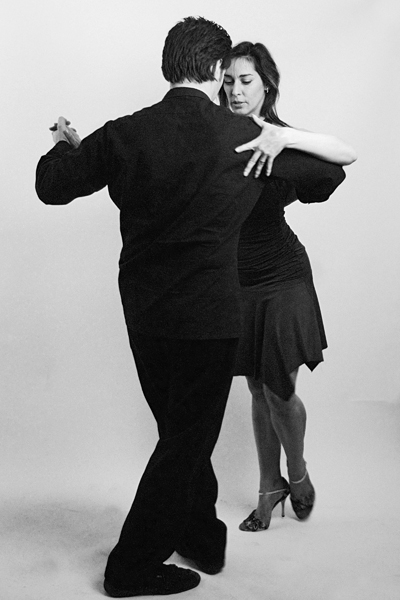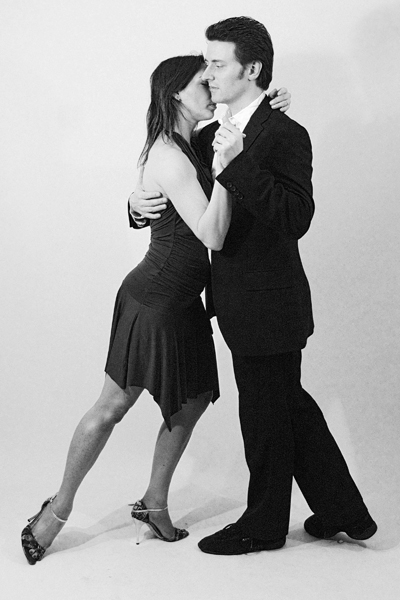Class Notes: June 2010
These are the class notes for June 2010 classes of "Core Tango" workshop for more details.
13th June: Free leg movement
Beginner class: "pulses"
After warming up, we spent some time working on leading free leg movements.
We did some "leg-swinging" exercises, standing on the mats and getting used to feeling our legs swing, in as "free" a matter as possible.
We then spent some time leading / following sideways "pulse"-type motions. Leaders, keeping the feet stable, led the followers to take sideways motions with their free legs; to either side.
This is a nice way to "stand in place" during social dancing, marking time to the music.
Key points
- Followers, as soon as you feel the lead, move your free leg. Don't fight it, let the leg move freely.
- Leaders, lead by moving your chest - not by moving the arms, or "shoulder shrugging".
Improver class: Parada with enganche
Using the free leg movement we worked on in the beginner class, we then worked on a particular movement using that technique - a block, followed by a leg wrap / hook ("Enganche").
We used a practice sequence, as follows:
- Leader sidestep left, change weight, pivot follower clockwise to face leader's left
- Follower takes a forward step, leader then blocks that forward foot with left foot
- Leader then leads follower's right leg to hook around leader's left foot
- Leader can either hold the foot there, or can flick it back (by straightening the left leg)
This movement can be done from the forward step of any ocho - we worked on it on the leader's right side also.
Key points
- Followers: don't "move the free leg", simply let the free leg be moved by the leader.
- Leaders: timing is crucial with the wrap - you need to apply the lead at exactly the right time so that the follower's leg moves naturally.
20th June: Embrace
There are two types of tango "embrace" (hold): open and close.
Key points
- Leaders, chest lead: don't move your arms / feet first.
- Followers, wait for the lead: if there's no lead, do nothing.
- Always keep in contact with your partner
- Ensure you have a "forwards intention" - for both leaders and followers. Don't lean back - if you do, your partner will feel off-balance as they'll have to lean forwards too much.
- Don't pull down on your partner's arms / shoulders; you shouldn't rely on your partner for support.
Beginner class: open and close embrace
Walking and dancing in close and open embrace.
The open embrace:

Key points
- In open embrace, followers get both tactile contact (from the arms) and visual clues (looking at the leader's chest) to understand the lead.
- Leaders, please ensure you lead from your chest. No "arm rowing".
- Similarly, leaders, don't pull or push your partner into position. Align yourself correctly, and your follower will align herself to meet you. Of course, this assumes that followers are following the chest movements...
The close embrace:

The close embrace is like an airport hug where you are meeting someone special after a long break.
Posture is basically the same as the open embrace; fully upright, weight over balls of the feet. But you have contact with your partner along the torso. Note that it's important to have space between your legs and your partner's legs, as in the diagram.
Key points
- Close is close - yes, it's intimate, but if you don't press against your partner, it doesn't work.
- If you do it right, close embrace makes leading and following easier, because you have more contact - at least for the steps covered so far.
- Don't force (pull) your partner into a close embrace - he/she may not be happy with that. Invite it, don't force it.
Improver class:
Going from close to open embrace, and when to use both.
- Close embrace is best for traditional-style tango dancing, without too many pivots.
- Open embrace is best if you're not comfortable dancing in close, and if you're doing a lot of pivoting-type moves.
- Probably best to avoid too much back-and-forth with the embrace during each track.
Practice sequence: close to open to close:
- In close, man sidesteps left and pivots to lead a back ocho step.
- Man continues to lead back ochos, opening out into open embrace.
- Reverse the lead, leading forward ochos
- When woman is pivotting clockwise on the man's right side, "wrap her in" to bring her in close
- Lead her to take a final forwards step, then pivot her to complete the "wrap in", bringing her back into to a close embrace
- And walk...
More information
27th June: Pivots
Beginner class: Ochos
We worked on pivots, first walking forwards / backwards by ourselves, and then in partners.
- Forward ochos - leading without moving the feet.
- Backward ochos - leading whilst moving in parallel.
Key points:
- Leaders: always lead the pivot first, then the step. Don't try to do both at the same time.
- Leaders: the step is in the same direction as the pivot.
- Followers: pivot first, then step. They are two separate motions - don't rush into one before the other.
- Followers: keep your chest facing towards your leader (that's the "dissociation" thing). Use the lat muscles to dissociate - don't use the momentum from your step to do the pivot.
Improver class: Overturned ochos and sacadas
For the improvers' class, we then took this further, by examining what we can do with more, or less, angles on the pivots - "underturned" and "overturned" ochos:
- Forward overturned ochos - the follower walks away from the leader.
- Forward underturned ochos - the follower walks towards the leader.
- Backwards overturned ochos - the follower walks towards the leader
- Backwards underturned ochos - the follower walks away from the leader.
So, effectively, altering the angle of pivot provides a way for the couple to move (as a couple) forwards or backwards. Typically, you'd use backwards underturned ochos the most for this, as they provide a way to move along the line of dance, and they're less effort than forward overturned ochos.
Next, we worked on a sacada sequence:
- Lead the lady into a forward ocho to the man's right.
- Sacada the woman's back foot with the man's right foot, stepping forward onto that right foot.
- Over-pivot the woman clockwise, whilst pivotting yourself
- Lead her into a forward step to your left, whilst taking a sidestep to your left to match.
- And repeat.
Basically, from the woman's point of view, she's doing two forward ochos, one of which is overturned.